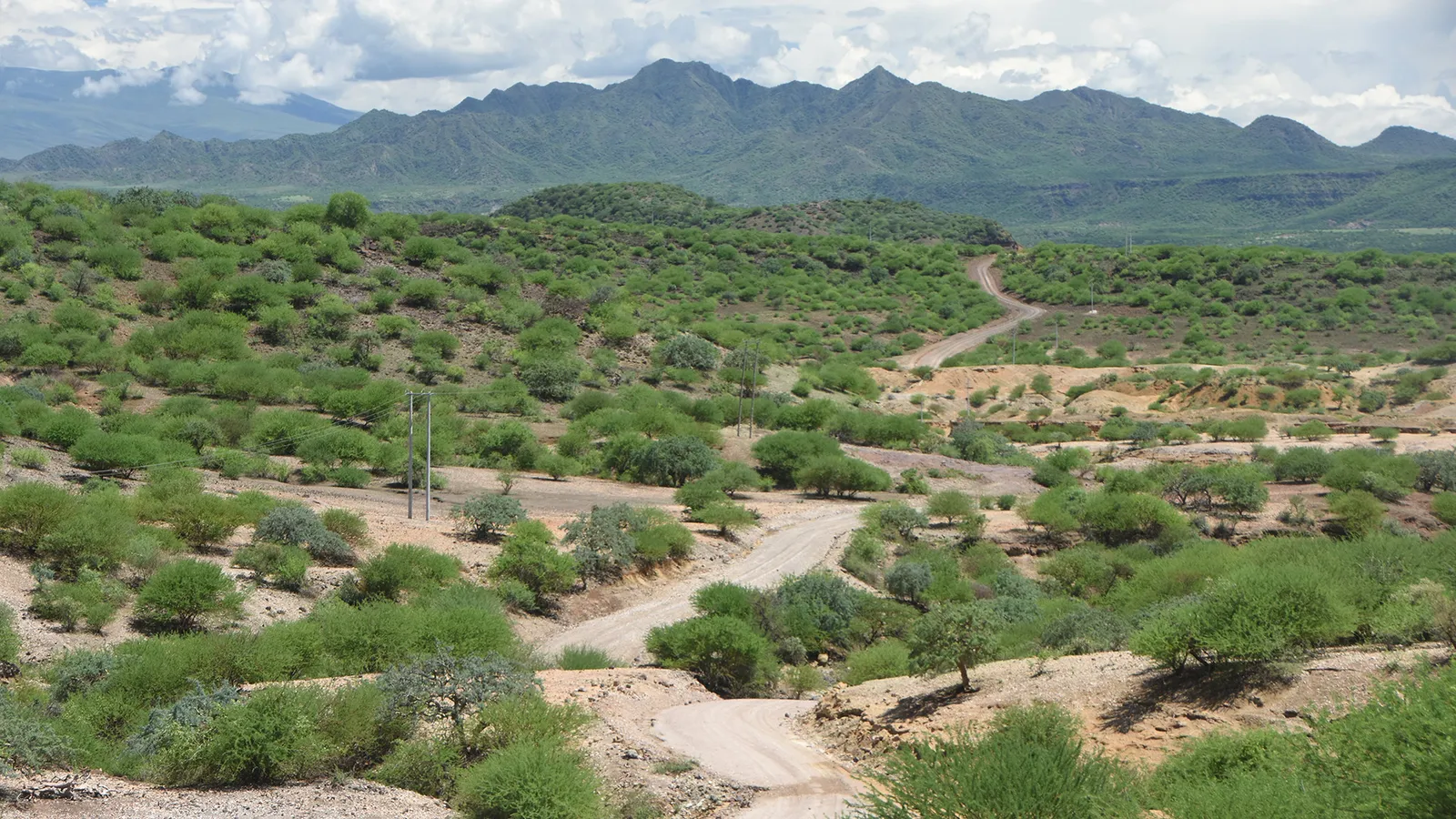The road less travelled to the Serengeti
The main road to the Serengeti is busy with endless safari vehicles. But there is a little-known back route that takes in Maasai herders, ancient fossils and volcanic craters.

The road less travelled isn't always easy. First of all, you need a road – or at least a track. Then you need the weather to be on your side. And, third, the destination has to be worth it.
I was reminded of this as I rumbled over the rutted tracks, some barely visible amid baking-hot dust, that struggled north from the town of Mto wa Mbu in northern Tanzania. With a nervous eye on the horizon lest rain clouds appeared and turned these tracks into slick mud, I continued north along the road towards Lake Natron and beyond to the Serengeti. One out of three would have to do.
But the truth was, it wasn't that bad at all. The road was rocky to be sure, but it soon evened out under a sky of piercing blue. The Great Rift Escarpment rose above plains where Maasai herders draped in blood-red shukas (thin blankets) crossed the countryside with their cattle. And whenever I pulled to the side of the road and turned off the engine, silence settled upon the landscape.
At Mto wa Mbu, I had faced a choice. It was an intriguing town, whose population of barely 15,000 souls included each of Tanzania's 120 ethnic groups. But the town's name, which means "River of Mosquitoes" argued against staying too long. I could have joined the steady stream of safari vehicles west along the paved B144 road that passes some of East Africa's finest wildlife destinations – Lake Manyara National Park, with its tree-climbing lions, or Ngorongoro Crater where rhinos and lions roamed in a lost world all their own. That road, too, led to the Serengeti, a vast and magnificent place where zebra and wildebeest migrated in their millions.
Or I could take the back road. Of course, I took the back road.
An occasional safari 4x4 stirred the dust. But the few cars were mostly farm vehicles crammed with locals hitching a ride along a route devoid of public transport. Rolling, high hills rose into the ancient volcanoes of the Crater Highlands, each with their own halo of cloud. Amid such grandeur, concentrating on finding my way, it took a while for me to notice Ol Doinyo Lengai, the Mountain of God. And once I noticed it, I could barely take my eyes off it.
On the final approach to Lake Natron, Ol Doinyo Lengai took on flawless form, as if drawn from a child's imagination of how a volcano should look. Riven with the textured lines of lava flows from past eruptions – the most recent large-scale eruption was in 2017, the seventh in 100 years – Ol Doinyo Lengai's slopes rose steeply to form a near-perfect cone.
Where Ol Doinyo Lengai was immediately and utterly appealing, its near-neighbour, Lake Natron, was, at first, more compelling than beautiful. In blazing sunshine, this vast expanse of salt, water and algae extended deep into the north, all the way to Kenya. The cauterised shore – encrusted salt mixed with the black lava of past eruptions – encircled a sea dotted with distant pink flamingos. I would later see how the elemental colours shifted with the angle of the Sun, as Natron's blue-green algae turned red.
Lake Natron is a place of extremes. The waters are so hot (60C/140F) and so alkaline (with a pH pushing 12) that a swim would probably kill you. And in the height of summer, the basin in which Lake Natron sits is like an anvil in a furnace.
That there is life here at all seems remarkable. The Maasai and their cattle eke out a hard-won living. The flamingos turn the waters pink. And along the lake's southern shore, there are more than 400 fossilised human footprints (only some of which are visible). At 120,000 years old, they're the world's oldest tracks left by Homo sapiensand tell the story of a long and unbroken human presence in this inhospitable place.
At sunset, it was difficult to know where to look. Lake Natron wore its vastness with austere beauty, while Ol Doinyo Lengai was bathed in the day's last magical light. And then, as the high walls of the Great Rift Escarpment cast the lakeside village of Engaresero into shadow, the day lost its sting. Locals emerged from shade and shelter into the relative cool of evening. Groups of young women strolled by the roadside, hand-in-hand and laughing. The young men gathered around campfires and communal TVs.
Life can be very hard out here. Everything is so extreme. But every night, when the sun goes down, there is no more beautiful place on Earth
"Life can be very hard out here. Everything is so extreme," said Naserian Leboo, a local Maasai woman whose family has lived here for more generations than she can count. "But every night, when the sun goes down, there is no more beautiful place on Earth."
The next morning, I took the road that climbed from the northern end of Engaresero and climbed through rocky, barren terrain, snaking up the Escarpment wall with views that changed with every passing kilometre. In the deep, stony valleys, Maasai herders and their goats foraged for what must have been the most meagre of pickings. At the top, Lake Natron shimmered before me like mirrored glass in the mid-morning sun.
These clifftops marked a boundary between two very different worlds. Down below, the boiling badlands of Lake Natron. Up ahead, the fertile highlands. With a last, lingering look at the lake from above, I turned my back on Natron and headed west, bound for the Serengeti.
For nearly 150km, the road meandered through a landscape tinged with green, an antidote to the barren, burnt landscapes around Lake Natron. Maasai villages shadowed the road that crossed a landscape cut through with streams and pretty green hills. Signposts led down tempting expedition trails through the gaunt Gol Mountains and to Olduvai Gorge, an archaeological wonder that's known as the "Cradle of Humankind" for the fossilised remains that are among the oldest evidence of human evolution. All the while, the candelabra-like euphorbia trees kept watch over fenced fields and village outskirts. For 50 blissful kilometres, from Sonjo to Wasso, the road was new and paved.
On the cusp of the Serengeti, north-west of Loliondo and a two-day drive from the regional capital of Arusha, the predominantly Maasai village of Ololosokwan tumbled down the hillside, its rocky main street lined with lean-to shelters and colourfully painted concrete homes. Under the watchful gaze of elderly Maasai men, I pulled into Maasai Honey.
Established in 2011, this local community project is a stirring success story with deep roots in the community where beekeeping has long been a Maasai tradition.
"When I was a child, we used to go out into the forest with our cattle," one of the beekeepers, Francis Kirando Letema, told me. "We always looked for the hives. Sometimes the bird we call the honeyguide would lead us to the hives, and we'd eat the honey right there. It was a real treat."
Maasai Honey's all-natural products – honey, lip balms, candles, mosquito repellents – are now sold in markets across Tanzania, including to many safari lodges across the country. What began as a project designed to provide income and community-wide empowerment has also come to challenge gender roles within local villages.
"In the past, beekeeping was always done by men," another beekeeper, Maria Shinini, told me. "But the tradition was being lost, and the old ways of doing things were outdated. We now use modern hives, and 80 to 90% of the beekeepers here are women. We started with just eight hives and eight women. Now we have 220 beehives being looked after by 40 women."
My bags full of honey jars, I drove down the Ololosokwan hill, crossed the stream and sped through acacia forests for the final run west. A pair of wary zebras grazed by the roadside, then an impala, soon a family of giraffes: the Serengeti was not far away. Sure enough, a view of the park's northern grasslands came into view away to the south-west.
And then, Klein's Gate, perhaps the quietest of all the Serengeti's entry points; there were no other safari vehicles, and I had passed just two on the long journey here from Lake Natron. This, too, was a transition point between two worlds, and exploring what lay beyond, across the savannahs of the Serengeti, was an enticing prospect.
But my excitement was tinged with regret that the road to here had finally come to an end.
-bbc







